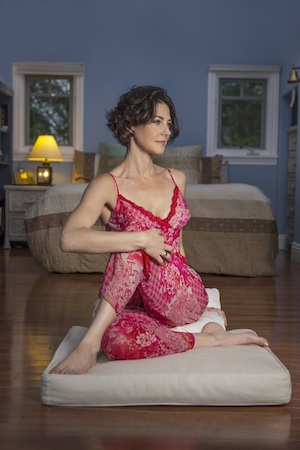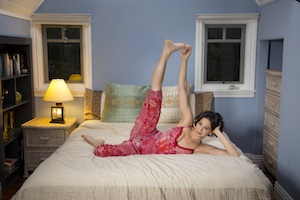When asked of the Buddha “Are you a man, or a God?” the Buddha replied…
“I AM AWAKE.”
I’ll start with the bad news—in some cases, chronic insomnia has no real cure. While there are many types of insomnia and many reasons for sleeplessness and sleep difficulties, for some of us, no matter the herbal treatments we seek, there may still be no end to the challenge.
It is important to know that if you have tried Western medicine, holistic medicine, meditation and more, and have still not “solved” your sleep issues – this does not make you a bad yogi. For some, trouble sleeping may be a “one day at a time” issue, and an opportunity to learn how to live fully with the challenge.
Yoga is not necessarily a cure for insomnia, but it can have some very soothing effects. If you are struggling to sleep because your mind is agitated, these yoga practices can often slow the system down enough for you to fall asleep. For those whose insomnia is unrelated to stress, these rejuvenative postures can relax the body and allow for regeneration, as a nourishing practice is essential. Dive in as if you were wrapping yourself up in a new set of sheets.
Rather than seeing our failure to sleep as a problem, it can be an opportunity to investigate our relationship to the night. There is an ecosystem of nocturnal animals with wisdom to share.
In Buddhism, the ultimate act is to “wake up” to the truth. If sleep evades you, possibly it can be a gift, giving us a nudge to ask “what does it mean to be awake?”
 Legs up the Wall- Viparita Karani
Legs up the Wall- Viparita Karani
The Bat
Bats are one of the most complex creatures. They are flying rodents, they hunt at night to avoid competition, and they emit noise designed specifically to produce an echo to reveal their prey. As the moon is reflected light, the bat lives by reflected sound. We can learn from the bat to utilize the art of reflection to reveal our path, point out what will nourish us, and show us what we need to see.
Instructions
Find a clear wall space or a closed door. Sit sideways against the wall and roll onto your side with knees bent in a fetal position with your hips close and your head away from the wall. Shimmy closer, keeping the hips 6-12 inches away from the wall and then allow the legs to rest, soles of the feet facing the ceiling, relaxed and supported.
It is said that for maximum benefit, lifting the arms up and away from the wall will increase blood flow to the head; however, you may find that it is just more comfortable to place the palms of the hands onto the belly and allow the elbows to relax to the floor. Feel free to let the legs relax and flop open, or strap the legs just above the knee to keep them together.
Rest here for a minimum of two to three minutes up to 10, 15 or even 20 minutes. Rise slowly from the pose. Release the legs by allowing the knees to bend into the chest. Roll to one side and allow the blood pressure to adjust, slowly climb yourself into a seated position. Pause for a few moments to ensure the effect the pose.
Adho Mukha Savasana
Downward Facing Savasana: Gravitational Surrender
For those with trouble sleeping, savasana can actually stimulate anxiety, since spending time on the back without sleep or rest can create an association between the position and the trauma of sleepless nights and worry. Since our physical position is connected to our brain patterns, shifting the body, even just slightly, can generate a dramatically different effect on the thought train.
Additionally, lying on one’s back can sometimes create feelings of vulnerability and lack of protection. On the other hand, this position of downward facing savasana turns the direction of energy flow into the earth. The natural downward flow of energy, or gravity, is called apana vayu by the yogis. As yogis, all we need to do is to ride the wave of the downward flow. Students who express irritation at traditional savasana often find lying on their bellies soothing.
Instruction
Lie face down on your belly on a padded surface. The arms can rest at the sides with the palms facing up or stacked to create a pillow. You may keep your neck straight by placing your forehead down or you may turn your head to the side and rest on your cheek. When choosing this option, be sure to time yourself and switch sides to create balance on the neck. When the legs are relaxed, the feet generally “flop” open with the heels dropping out gently to the sides. Allow this to happen for maximum relaxation.
Follow the breathing tips and remain in adho mukha savasana for 3-20 minutes. Press yourself back into child’s pose for three to five breaths and then press up to sitting.
Moon Breath
In the yogic system, the right side of the body is symbolized by the Sun, “ha” and the left by the Moon, “tha.” Together, they create Hatha, a balance of sun and moon energies. Most yoga teachers lead practices that begin with the right side of the body, or the Sun side. Whatever “side” we do first, we do best, as by the time we get to side two, the body is fatigued. Thus, the sun side of the body is often receiving our full attention, while the Moon may be slightly short changed. It is no surprise then, that we often are left energized, but not necessarily relaxed.
Chandra Bhedhana is a circular breathing technique which nourishes the Moon channel and softens the Sun; to do so, we inhale through the left nostril and exhale through the right.
When practicing, reflect on the power of the Moon, the energy of our internal world. To this day, most religions and cultures operate on a Moon calendar. The Moon, although quiet in countenance, is a powerful force on the water element; it affects the ebb and flow of the ocean and the tides. As our bodies are mainly composed of water, it is no wonder that the moon has such a powerful effect on us. Honoring the moon is a practice of humility and an opportunity to ask for guidance.
Instruction
Find a comfortable seated position. (You may sit on a chair or rest your back against a wall.) The priority is to sustain an extended, long spine as the tendency is to lose the erect posture due to fatigue.
Locate the middle and index finger of the right hand (even if you are left handed.) Make a peace sign with the right hand and then place the tips of those two fingers into the notch where the forehead and nose meet. To balance the effort of the arms, you can use the left palm to support the right elbow.
Sitting tall, slightly drop the chin. Exhale through both nostrils, then with the right thumb, close off the right nostril and inhale through the left. Pause. Then, use the ring finger to close the left nostril and exhale out the right.
This is a circular breath, so you are always going inhaling through the left nostril and exhaling through the right. Try to balance the length of the inhalation and of the exhalation, then lengthening the breath once the pace is comfortable. Becoming curious about the path the breath travels helps us stay present and become more personally aware.
Practice a minimum of three rounds to feel the effects; continue up to five minutes. Complete with a few rounds of softly coaxing the air to travel through both nostrils with ujjayi breathing.
Supported Child’s Pose
Possum
Thanatosis, or “playing dead,” is a famous defense mechanism of the possum to ward off unwanted attention of a predator or potential mate. So much so that it has even become known as “playing possum.” One of the few nonviolent acts of defense, “playing dead” can be a powerful tool in navigating adversity. We all struggle with challenges in the urban jungle regarding career and relationships. Often, instead of reacting violently, this strategy can be successful in making a problem simply go away. And whether or not we are facing adversity, coming into relaxed stillness can be beneficial to our nervous systems: By playing dead for a few minutes, we can awaken and be reborn feeling fresh and rejuvenated.
Instructions
Lay out a yoga mat or find a soft surface, then place a blanket over the entirety of the surface to create padding. Find a yoga bolster or stack several folded blankets to make a rectangular supported lift at least six inches high, but no more than a foot or foot-and-a-half off the floor.
Sit in a kneeling position, bringing the big toes together and the knees as wide apart as comfortable. Roll up a hand towel and place it lengthwise under your ankles for support.
Place the short end of the bolster so the length of the bolster stretches away from you; rest your torso on it. You can either have the bolster close enough into you so that your head floats off the top of the bolster and slightly hangs forward symmetrically, or you can allow the bolster to support your head as well and turn your head to one side. When choosing this option, be sure to time yourself and switch sides of the head. The hands can rest on the bolster to create a pillow, or bring the arms down by the sides, whichever is most relaxing. Follow the tips to work with the breath and remain here for 2-20 minutes.
(With breath retention on the exhalation)
The Owl
The owl is possibly the most famous of all night creatures. Its signature move is extreme flexibility of the neck, turning the head signifies the enhanced perspective, or “seeing things from all sides.” The owl also perceives even small amounts of light within the darkness, allowing it to past the obvious to give the owl its reputation of being wise.
Practicing breath retention on the exhalation allows the body to slow down and feel the power of emptiness. Conversely, holding the inhale is invigorating and helps us to feel full. When practicing on one’s own, breath retention should be simple, without effort. For a full investigation of pranayama techniques, please practice under the guidance of a teacher.
Instructions
Sit comfortably on a cushion, blanket, or bolster, with your left leg bent, left heel pointing towards the outside of the right hip, knee pointing straight ahead. The right leg goes over the left with the right knee pointing directly towards the ceiling, right foot on the floor just to the left of the bent left knee.
Place your right fingertips down four to six inches away from the outside of the right hip to create length in the spine. Place your left hand onto the right knee and guide it towards you or bring the outside of the left arm outside the right thigh.
Begin with a nice deep inhale to sit up tall and then gently twist to the right on the exhale. Look over the right shoulder as far as is comfortable for you. Continue to lengthen the spine as you inhale and twist further on the exhalation.
Softly holding the exhalation soothes the nervous system while holding the inhalation wakes us up. At the end of each exhalation, pause for a few moments (try counting to a slow five) to feel empty, without straining. When you inhale, make sure NOT to gasp or gulp air in.
Hold the twist for at least one full minute then release and switch sides by switching the crossing of the legs. This is a long hold for a twist, so please be gentle in the transition.
Reclined Buddha, or Vishnu in Yoga Nidra
Anantasana, one of my top five yoga poses, is often considered to be the deity Vishnu resting on his serpent in the act of Yoga Nidra (a state beyond sleep). As Yoga Nidra is one of my main yoga practices, I love this interpretation of the pose.
It is also called The Reclined Buddha. The Buddha in this reclined position has many meanings: One is to show the Buddha in his final moment of enlightenment before his death. The other interpretation is the Buddhist notion that even when sleeping, mindfulness is practiced; this is a reminder that sleep is not a moment to check out.
It can be agreed that whatever the ascribed archetypal origin, Anantasana is a posture of enjoying the relaxed moment.
While practicing Anantasana, find the places in the body that are afraid to relax. Allow the head to become heavy in the hand, allow the belly to spill forward in an unattractive manner. Ask yourself,“Where else might I let go?” “If I were to really let go, how would I feel?” And if you’re courageous… “Who is the ‘I’ that is letting go?”
Instructions
Lie on your right side with your knees bent into your chest and your head resting on a flat right arm. Your left hand drapes over your hip with the elbow heavy. Enjoy stage one for a few long breaths. Then, bend the bottom right arm until the elbow is pointed out to the side and the head rests in the right hand. There should be no effort in the neck, the head should relax fully. (This is my favorite stage; you can stay here for minutes if you like!) Lastly, and only if you want to add more, take the middle and index fingers of the left hand and take hold of the left big toe. Slowly and gently begin to straighten the left leg bringing the left foot towards the ceiling. Stretch to your comfortable level of flexibility. Relax here for 30 seconds up to several minutes. Be sure to practice for the same amount of time on side two.
Breath Suggestions for All Poses
Begin breathing in through the nose and then slow down the exhalation through the mouth allowing it to be slower and longer than you may think you can do, until you are fully empty. Beginning this way will kick start the relaxation process signaling your body that it is time to slow down. Then watch the breath slow itself down on its own.
After a minute or so, the breath will find its own equilibrium. Yes, you may practice ujjayi breath for these poses, but with only a soft soothing sound, a meditative breath for these restorative poses.
Rather than altering the breath, simply observe the path the breath travels. Notice if the breath pattern is smooth, if the inhalations and exhalations feel balanced. Observing the breath is a form of mindfulness, which is a great technique for steadying the thoughts.
When we are sleeping we are not altering the breath, and these poses are meant to lull us into sleep, so once the tension has been cleared from the breath, allow it to settle and mimic sleep- your body will get the hint.
Nidra Vicchara
Vicchara is the practice of inquiry, the Sanskrit word nidra means sleep. The act of asking a question brings us into the present moment. Ask yourself some questions to begin the practice of inquiry. When engaged in this practice, I recommend a journal dedicated to sleep and rejuvenation. When practicing vicchara, don’t be seduced by the desire to jump to an answer. Once we “know” something, we file it away and are no longer open to new wisdom. Keep asking! Here are some to get you started…
•How or when did you first experience trouble sleeping?
•How has your trouble with sleep affected your relationship to others?
•How has it affected your ability to achieve your goals?
•What steps are within your control that you can take to heal your relationship to sleep?
•How can your increased wakeful hours be best utilized?
•Why do you think that sleep has manifested itself this way to you specifically?
•How might you see this “problem” as a gift? This “liability” as an asset?
•Most importantly, what does being “awake” mean to you?
Photos by David Young-Wolff: David Young-Wolff loves to tell a story in a single frame. Never satisfied with the ordinary, he strives to create exciting images with a unique twist. In addition to his assignments, he is currently working on two projects. One is coming to LA, which involves photographing people who are moved to LA from other countries. He is also shooting photos to illustrate an upcoming book, Navajo Mothers, Navajo Daughters. davidyoung-wolff.com
Hair & Makeup by Megan Porschen





